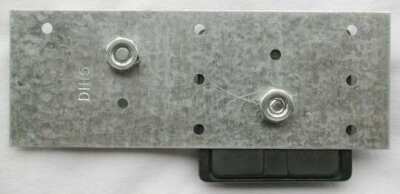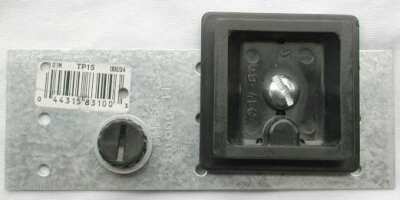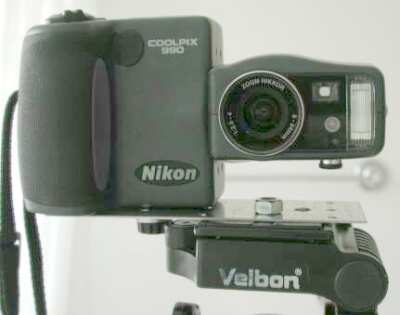Introduction. Parallax errors are a common problem in stitched panoramic images. Sascha Kerschhofer and digitalkamera.de both have detailed explanations of parallax errors, but simply put, they are caused whenever the camera does not rotate around an imaginary axis through the central, or "nodal" point of the lens. On many cameras this is a result of their design -- On the Nikon 990, for example, the tripod mount is about two inches away from the axis that runs through the lens. Tripod heads that offset the camera so that it rotates around the axis are available from companies like Kaidan, but can cost several hundred U.S. dollars. Additionally, most of these heads are only designed to work with the camera in the portrait orientation.
Because most of my stitched photographs are taken with the camera in the landscape orientation, and I rarely use the fish-eye or other auxilliary lenses that are popular with panorama photographers, I decided to make my own tripod head. Not to mention the fact that I was less than excited about the prospect of spending several hundred dollars for a panoramic tripod head to sit on top of my $20 tripod. I'm not breaking any new ground here...many others have made their own panoramic tripod heads and their instructions are easily found on the web. As a guide, I used Judy Arndt's diagram showing the exact position of the nodal point for the Nikon 990. Nikon's European site says that the nodal point for the Nikon 990 is between 20.5 (at wide-angle) and 32.3mm (at telephoto) behind the lens. The 360Texas web site has some diagrams showing the nodal point when the Nikon is used with auxilliary lenses. Kaidan's web site has a simple tutorial on how to find the nodal point for any camera. Because I don't have access to any specialized tools, I wanted something that could be easily constructed from readily available materials. So, off I went to Home Depot (the local "mega-hardware-store") to see what I could find.
Materials. After about half an hour of wandering up and down the aisles (it is truly mind boggling to see how many varieties of screws/doorhandles/electrical switches/plumbing fixtures/etc. there are), I came home with the following items:
- 1 "Tie Plate" (SKU: 044315831003). Cost $0.29.
- 1 bag 1/4 inch diameter, 1/2 inch length, coarse thread machine screws. Cost $0.79.
- 3 1/4 inch washers. Cost $0.06.
Construction. The central part of the whole apparatus is the tie plate. It is designed to join wooden beams together, but what caught my eye was its relatively small size, its strength, and the fact that the pre-drilled holes are almost exactly the right distance apart to offset the Nikon 990's tripod mount and nodal point. I had to enlarge a couple of the holes with a drill so that the 1/4 inch tripod screws would fit though the holes in the tie plate, but made no other alterations to the plate. The pictures below show how I assembled the pieces.
Conclusion. So far, I've only had one day to test the new head, but it appears to work well. I've taken a couple of panoramas with elements in the near foreground. There is still a little parallax distortion left (perhaps my calculations weren't completely precise), but almost nothing compared to what exists without the head. This is probably the best $1.14 I've invested in my camera equipment to date!
 |
|
 |
|
 |